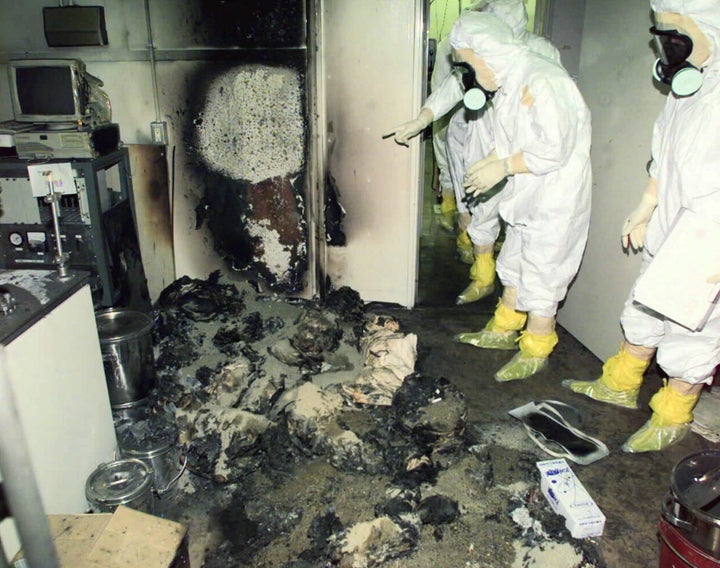
Nuclear power is not evil; it's the devil. Evil of our own making can be overcome. The devil cannot be overcome, not even if we ourselves conjure him into being. This is why staking our future on nuclear power is a pact with the devil.
Spokesmen for the nuclear lobby claim nuclear reactors are safe. By safe they mean we can master them under all circumstances. This would be essential, as a reactor requires constant control to remain operational. If an essential part of the control system breaks down, the reactor core heats up, and if the problem is not remedied in time, the core melts. The radioactive radiation released by a meltdown sooner or later proves lethal for people, the same as for all forms of life higher than insects and grass. Failing to control other technologies creates local problems -- the breakdown of navigation systems, power-shortages, unsafe drinking water, poisonous air -- and while these are bad enough, they do not kill hundreds of thousands of people. A major nuclear breakdown does.
The present near-meltdown of the super-technology installation in Japan has made it clear that perfect and reliable control is not possible. There are too many eventualities that cannot be foreseen. We live in a complex world where myriad processes unfold, and one way or another they all interact one with the other.
The disaster in Japan occurred because the combination of factors that triggered it was not foreseen: it was ipso facto implausible. Friction among continental tectonic plates hundreds of miles offshore created a quake on the ocean floor, and this was communicated to the land-mass of Japan. This in itself could be foreseen: no problem, Japan's nuclear facilities have been built to withstand earthquakes. But the offshore quake also created a tsunami, and the flood-waters destroyed a part of the power-grid on land. That, too, was foreseeable. There are many ways that the power-supply of reactors can be assured, it's part of their fail-safe mechanism. But the tsunami also produced a failure of the cooling system in such a massive way that it could not be readily remedied. That was not foreseen. As a result the core of six powerful reactors have gone critical or near-critical.
If an offshore quake can create near-criticality in a nuclear reactor, could there not be quakes that are not offshore but right under a reactor that create a critical condition? There are numerous reactors right in, or near, major earthquake zones, for example, the aptly named "Diablo Canyon" facility in California -- sitting right on the San Andreas and the Hosgri faults. It is designed to withstand a quake of 7.5 magnitude -- but what if the quake is of magnitude 8 or higher? Besides, instabilities are produced not only by nature, we also produce countless instabilities ourselves. Our world is financially, economically, politically, and socially unstable, in some respects critically so. Because our financial, economic, political, and social systems interact with our natural environment, and because our natural environment is overexploited and unbalanced, our world is also ecologically unstable. In this condition, crises of one kind or another are bound to happen, even if we do not know where and when. The causes of a potential crisis are too complex; there are too many factors and too much uncertainty to permit reliable forecasts. Yet a major crisis could trigger a nuclear breakdown, whether by accident or by design.
Nuclear breakdowns are not caused only by natural catastrophes, they can also be precipitated by terrorism, war, and violence by desperate masses. And despite international safeguards, unscrupulous leaders can still convert the reactors to the production of nuclear weapons.
Nuclear reactors are not evil: they produce the power that runs the modern world. They are present on every continent, often near urban and industrial megacomplexes. This is prima facie good -- the installations generate clean energy from a practically infinite source (even if they pose still unsolved problems of the disposal of radioactive wastes and the decommissioning of aging and obsolete systems). But nuclear reactors are the devil, because in our critically unstable world we cannot be sure of remaining in a position to control them.
Is it reasonable to stake our future on a devilishly uncontrollable, potentially lethal technology? If we did not have other options, perhaps it would be. But we do have other options -- a vast range of alternative energy technologies is coming online, and they are just as clean but far less dangerous than the nuclear. Shouldn't we see if we could make good use of them now, while we still have a chance? Or are we already irrevocably committed to a pact with the devil?
The cataclysm in Japan produced an unexpectedly positive fallout: it opened a worldwide debate on the nuclear option for our future. More exactly, on whether we have a future if we go fully and globally nuclear. Could it be that "our nuclear future" is an oxymoron? If it is, we should see about changing course: decommissioning aging reactors, stopping the construction of new ones, and investing in safe alternative technologies. The time is late, but perhaps not too late. We had better wake up and start assessing our options.